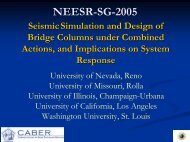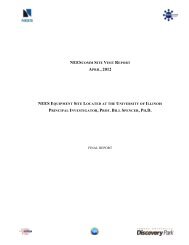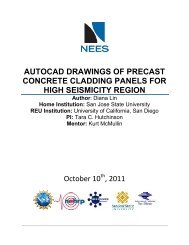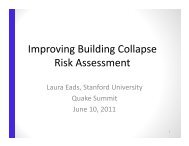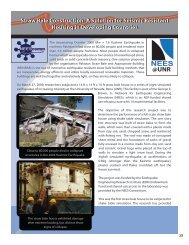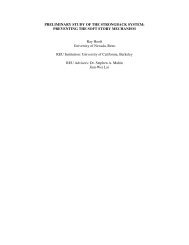TSUNAMI WAVE BREAKING BEHAVIOR ON A REEF WITH A ...
TSUNAMI WAVE BREAKING BEHAVIOR ON A REEF WITH A ...
TSUNAMI WAVE BREAKING BEHAVIOR ON A REEF WITH A ...
Create successful ePaper yourself
Turn your PDF publications into a flip-book with our unique Google optimized e-Paper software.
Figure 9: Roughness on the slope (BS1, BS2, BS3) consistently caused the waves to crash sooner as seen by the lower values<br />
of crashing distance (dc).<br />
4.2 Reef Geometry<br />
The bottom bathymetry of the wave flume was modeled after a reef and had a significant effect on the<br />
experiment. The steep slope of 1:12 followed by a flat reef produced results that showed a higher<br />
breaking index and lower breaking water depth compared to studies done on a mild slope with no reef<br />
crest (Grilli et al. 1997).<br />
A breaking index of Hb/hb=0.80 for solitary waves is commonly used (Smith, 2002), however it has been<br />
found to be inaccurate for reef bathymetry. A more improved, yet still empirical, relationship was found<br />
by Grilli (1997) as Hb/hb=0.841exp(6.421So). Using this formula, the values of Hb/hb for this experiment<br />
should have ranged from 0.94 to 1.01. However this study shows a significantly higher breaking index<br />
(Figure 10). The mean index was Hb/hb= 2.878 with a standard deviation of ±0.560. These results are<br />
most likely due to the geometry of the reef with the steep slope followed by flat surface.<br />
By comparing the data from this experiment to an empirically derived formula for the breaking water<br />
depth for solitary plunging breakers hb/ho= 0.149/(So/Ho’)^0.523 (Grilli et al 1997) , the breaking depth<br />
was found to be consistently lower (Figure 11). The steep slope and reef flat were the cause of this<br />
behavior.<br />
9






